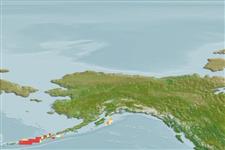klasifikasi / Names
Nama-nama umum | Sinonim (persamaan) | Catalog of Fishes(Marga, Jenis) | ITIS | CoL | WoRMS | Cloffa
>
Perciformes/Zoarcoidei (Eelpouts and pricklebacks) >
Zoarcidae (Eelpouts) > Lycodinae
Etymology: Lycodes: Greek, lykos = wolf + Greek, suffix, oides = similar to (Ref. 45335); akuugun: Named after the Aleut name for the native inhabitants of the Islands of Four Mountains, the region where the species was discovered; noun in apposition.
Environment: milieu / climate zone / kisaran kedalaman / distribution range
Ekologi
laut dasar (demersal); kisaran kedalaman 121 - 460 m (Ref. 56970). Temperate
Northeast Pacific: Aleutian Islands.
Size / Weight / umur
Kematangan: Lm ? range ? - ? cm
Max length : 32.4 cm SL jantan/; (Ref. 56970)
deskripsi pendek
Kunci identifiaksi (pengenalan) | Morfologi | Morfometrik
duri punggung lunak (Keseluruhan (total)) : 107 - 120; Sirip dubur lunak: 97 - 103; vertebrata, bertulang belakang: 113 - 120. Diagnosis: Distinguished from the majority of its congeners (46 of 61 currently recognized species) by the ventral position of the lateral line. Among species of Lycodes with a ventral lateral line, the new species is distinguished from brevipes, diapterus, hubbsi, microporus, nakamurae, nishimurai, and ocellatus by the absence of scales on the nape. It is distinguished from all remaining congeners except pectoralis and vahlii by its comparatively high vertebral count (113-120 vs. 94-113 in brunneofasciatus, caudimaculatus, frigidus, gracilis, and obscurus). It is distinguished from pectoralis and vahlii by the presence of an interorbital pore, number of anal-fin pterygiophores preceding the first haemal spine (5-7 vs. 2-4), and the color pattern (pectoralis and vahlii lack light bands on the dorsal fin, light blotches on the upper body, and the bicolor appearance of the head, body, and pectoral fin) (Ref. 56970).
Body shape (shape guide): eel-like.
The species were collected in hauls dominated by Atheresthes stomias, Theragra chalcogramma, Hippoglossus stenolepis, and Sebastes alutus; also with Lycodes diapterus and L. concolor. Bottom temperatures of collection sites ranged from 3.3-4.3 °C. Stomach contents of 2 specimens has partially digested sea urchin tests (Ref. 56970).
Life cycle and mating behavior
Kematangan | Reproduksi, perkembang biakan | Pemijahan | telur-telur | Fecundity | Larva
Stevenson, D.E. and J.W. Orr, 2006. A new species of Lycodes (Perciformes: Zoarcidae) from the Aleutian Islands. Copeia 2006(1):77-82. (Ref. 56970)
Status IUCN Red List (Ref. 130435: Version 2025-1)
ancaman kepada manusia
Harmless
penggunaan manusia
Alat, peralatan
laporan khas
muat turun XML
Sumber internet
Estimates based on models
Preferred temperature (Acuan
123201): 3.7 - 4.5, mean 3.9 °C (based on 6 cells).
Phylogenetic diversity index (Acuan
82804): PD
50 = 0.5000 [Uniqueness, from 0.5 = low to 2.0 = high].
Bayesian length-weight: a=0.00120 (0.00058 - 0.00248), b=3.10 (2.91 - 3.29), in cm total length, based on LWR estimates for this (Sub)family-body shape (Ref.
93245).
Trophic level (Acuan
69278): 3.4 ±0.5 se; based on size and trophs of closest relatives
Daya lenting (Acuan
120179): Rendah, Waktu penggandaan populasi minimum 4.5 - 14 tahun (Preliminary K or Fecundity.).
Fishing Vulnerability (Ref.
59153): Low to moderate vulnerability (30 of 100).
🛈
